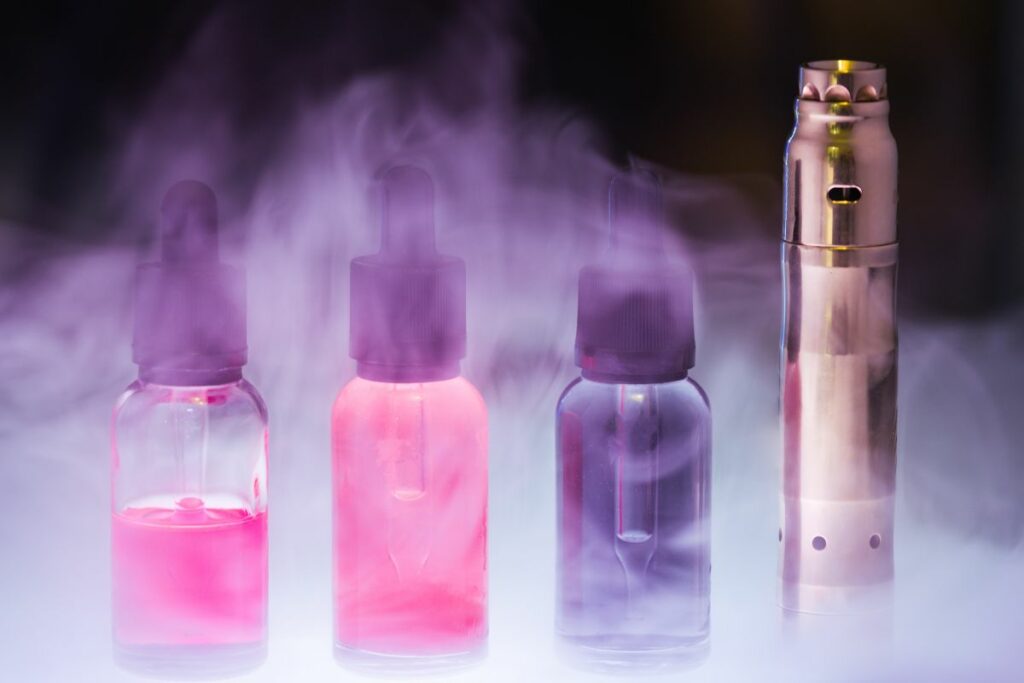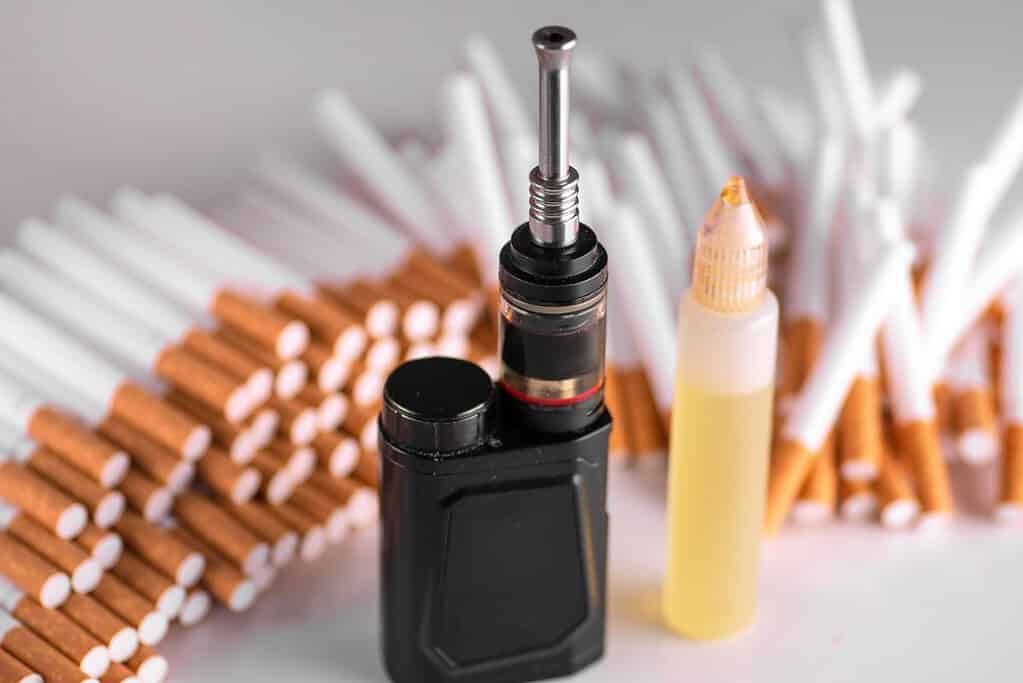What Does Vaping Feel Like: An Expert Analysis
Vaping has become a popular alternative to traditional smoking, with many people curious about the experience it provides. E-cigarettes and vaporizers heat up a liquid, referred to as vape juice, which then turns into vapor that can be inhaled. The feeling of vaping can differ from person to person and is influenced by factors such as the type of e-cigarette, vape juice, and individual preferences.
For those who have smoked traditional cigarettes, they may find that vaping gives off a smoother sensation compared to the harsher feeling of smoking.
NEW CUSTOMER DISCOUNT
Save 15%
15% OFF YOUR ENTIRE ORDER FOR NEW CUSTOMERS USE CODE WELCOME15!

Others experience a sense of relaxation or satisfaction due to the various flavors and nicotine content available in vape juices. However, it is important to note that the long-term effects of vaping are still not entirely understood, and users should be aware of potential health risks.
As vaping grows in popularity, understanding the sensations and experiences associated with it becomes essential. By providing a clearer picture of what vaping feels like, potential users can make more informed decisions about whether it’s a suitable alternative to traditional smoking methods.
Table of Contents
Understanding Vaping
Vaping is the act of inhaling and exhaling the vapor produced by an electronic cigarette (e-cigarette) or similar device, such as a vape pen, mod, or pod vape. These devices work by heating a liquid, commonly referred to as e-liquid or vape juice, which contains nicotine and various flavorings. The resulting vapor, upon inhalation, provides a similar sensation to smoking traditional cigarettes, with some significant differences.
One notable aspect is that electronic cigarettes come in various forms, ranging from small, pen-shaped devices called vape pens to more advanced setups known as mods. Moreover, electronic cigarettes are also available in a discreet, disposable format, or as pod vapes that use pre-filled cartridges. This variety gives users multiple options to choose from based on their preferences and needs.
When it comes to the feeling of vaping, users often report a smoother and more pleasant experience compared to traditional tobacco smoking. The vapor is typically cooler and less harsh on the throat than conventional cigarette smoke, reducing the likelihood of coughing or throat irritation. Furthermore, the e-liquids used in vaping devices offer a wide range of flavors, making the experience more enjoyable for many users.
Another aspect to consider is the nicotine delivery in vaping devices. Vape pens, mods, and pod vapes allow users to choose from different e-liquid nicotine strengths, giving them control over the amount of nicotine they ingest. Some people find that vaping helps them gradually reduce their nicotine intake, as they can opt for lower concentrations of the substance in their e-liquids over time.
In conclusion, understanding the ins and outs of vaping and the various types of devices available, such as e-cigarettes, vape pens, mods, and pod vapes, is crucial for users to make informed decisions about their vaping experiences. Between the smoother sensation, diverse flavors, and customizable nicotine levels, vaping offers an alternative for those seeking a less harmful way to satisfy their nicotine cravings.
The Act of Inhaling Vapors

Vaping is the act of inhaling vapors produced by electronic devices like e-cigarettes. These devices contain a liquid solution that is heated, turning into an aerosol that users inhale. The process of vaping is generally regarded as an alternative to traditional smoking, however, it is important to understand the experience to make informed decisions.
When first inhaling vapor from an e-cigarette, users may experience a sensation in the back of their throat, similar to smoking a traditional cigarette. This is often referred to as a “throat hit” and may provide a satisfying feeling for some individuals. The aerosol travels through the mouthpiece and enters the airways, where it is drawn into the lungs.
As the vapor moves through the airways, it may trigger a range of sensations depending on the ingredients and the user’s preferences. Some vapers enjoy the taste and smell of various e-liquid flavors, while others prefer the feeling of inhaling a cloud of vapor. The amount of vapor inhaled can also be controlled through the use of different device settings and techniques.
Although vaping may offer fewer health risks compared to smoking combustible cigarettes, it is not without potential harm. Inhaling aerosol has been linked to lung damage, particularly when using e-liquids containing harmful substances. In some cases, these substances can cause irritation in the throat and airways, as well as negatively impact lung function.
In conclusion, the act of inhaling vapors while vaping can be a unique and varied experience that differs from traditional smoking. However, it is crucial to be aware of potential risks and make informed decisions to protect one’s health.
Components of Vaping Devices
| Component | Description |
|---|---|
| Battery | Provides power to the device, typically rechargeable. |
| Atomizer | Contains the heating element (coil) and wick to vaporize the e-liquid. |
| Coil | A wire or metal component that heats up to vaporize the e-liquid. |
| Wick | Material (usually cotton) that absorbs and delivers e-liquid to the coil. |
| E-Liquid Tank/Reservoir | Holds the e-liquid that is vaporized by the atomizer. |
| Drip Tip/Mouthpiece | The mouthpiece where the user inhales the vapor. |
| Airflow Control | A mechanism to adjust the amount of air entering the device, affecting vapor production and draw resistance. |
| Button or Firing Mechanism | Activates the heating element (coil) to produce vapor. |
| LED Display/Indicators | Provides information like battery life, wattage, or voltage settings. |
| Tank/Cartridge | Holds the e-liquid and can be removable or built into the device. |
| USB Port | Used for charging the battery or updating firmware in some devices. |
| Housing/Chassis | The outer casing or body of the device, which houses the components. |
| Control Buttons | Allows the user to adjust settings like wattage or temperature. |
Vaping devices, commonly known as e-cigarettes or vape pens, are composed of multiple key components that work together to provide the user with a unique experience. The main parts of a vaping device include the tank, battery, heating element, and cartridge.
The tank is the container that holds the e-liquid, which is the substance that is vaporized during use. Tanks come in various sizes and materials, such as glass or stainless steel, and can often be customized to suit the user’s preferences in terms of appearance and capacity.
The battery is responsible for providing power to the device and activating the heating element. Batteries come in different sizes, voltages, and capacities, affecting the overall performance and life of the vaping device. Some devices feature rechargeable batteries while others may use disposable ones.
As heat is crucial for the vaporization of e-liquid, the heating element plays a significant role in the functionality of a vaping device. Commonly referred to as the atomizer or coil, the heating element is responsible for converting electrical energy from the battery into heat. This heat then vaporizes the e-liquid in contact with the coil, creating the vapor that users inhale.
Lastly, the cartridge serves as a vessel for the e-liquid and heating element. It typically consists of a mouthpiece through which the vapor is inhaled, as well as a chamber that houses the heating element and contains the e-liquid. Cartridges can be refillable, allowing users to change flavors or replenish their e-liquid, or pre-filled and disposable, providing a convenient solution for users who do not wish to handle e-liquid directly.
In summary, the components of a vaping device – the tank, battery, heating element, and cartridge – play distinct roles in the overall vaping experience. They can be customizable to suit individual tastes and preferences, catering to a wide range of users who seek an alternative to traditional tobacco smoking.
E-Liquids and Their Ingredients

E-liquids, also known as vape juice, are the liquids used in electronic cigarettes and vaporizers. These liquids are made up of several key components that contribute to the overall vaping experience. Major ingredients in e-liquids include nicotine, flavors, propylene glycol, and vegetable glycerin.
Nicotine is an optional ingredient in e-liquids, as vape juices are available in varying nicotine strengths or even nicotine-free options. Nicotine provides the familiar sensation associated with traditional tobacco products, and its concentration can be tailored according to the user’s preference.
| Type of E-Liquid | Description |
|---|---|
| Freebase Nicotine E-Liquid | Contains nicotine in its purest form without any additives. It provides a stronger throat hit and is commonly used in sub-ohm devices. |
| Nicotine Salt E-Liquid | Contains nicotine in a salt form, which is smoother to inhale and allows for higher concentrations of nicotine without excessive throat hit. Often used in pod systems. |
| CBD E-Liquid | Contains cannabidiol (CBD) extract, a non-psychoactive compound found in cannabis. Used for relaxation and potential therapeutic benefits. |
| THC E-Liquid | Contains tetrahydrocannabinol (THC), the psychoactive compound in cannabis. It provides a high when vaporized. |
| VG-Based E-Liquid | Uses Vegetable Glycerin (VG) as the primary base. Produces denser vapor clouds and is suitable for those sensitive to propylene glycol. |
| PG-Based E-Liquid | Uses Propylene Glycol (PG) as the primary base. Provides a stronger throat hit and is thinner in consistency. |
| Max VG E-Liquid | Contains the highest possible percentage of VG for maximum vapor production. Often preferred by cloud chasers. |
| High PG E-Liquid | Contains a higher ratio of PG to VG. Provides a stronger throat hit and is commonly used in older, higher-resistance devices. |
| Zero Nicotine E-Liquid | Contains no nicotine, suitable for vapers who have quit nicotine but still enjoy the vaping experience. |
| Flavorless E-Liquid | Contains no added flavors, providing a pure vaping experience with just the base and, if applicable, nicotine. |
| Fruit-Flavored E-Liquid | Offers a wide range of fruit-inspired flavors, such as strawberry, mango, apple, etc. |
| Dessert-Flavored E-Liquid | Emulates the taste of various desserts, like custard, cake, cookie, etc. |
| Menthol/Mint E-Liquid | Provides a cooling menthol or mint sensation, often preferred by those who used to smoke menthol cigarettes. |
| Beverage-Flavored E-Liquid | Offers flavors like coffee, cola, lemonade, tea, and energy drinks. |
| Tobacco-Flavored E-Liquid | Mimics the taste of traditional tobacco, catering to those transitioning from smoking to vaping. |
| Candy/Sweets E-Liquid | Provides sweet and sugary flavors like bubblegum, cotton candy, gummy bears, etc. |
| Bakery E-Liquid | Offers flavors like sugar cookie, donut, cupcake, cinnamon roll, and other baked goods. |
| Nutty E-Liquid | Features nut-inspired flavors like almond, peanut butter, hazelnut, etc. |
| Creamy E-Liquid | Offers creamy and milky flavors like vanilla cream, whipped cream, custard, ice cream, etc. |
Flavors play a crucial role in e-liquids, as they create the taste and aroma of the vapor. E-liquid flavorings can range from simple single-note flavors like fruit or menthol, to complex blends replicating popular food or drink items. The variety of flavors available allows users to customize their vaping experience, though it is important to remember that the quality and safety of different flavoring ingredients might vary.
Propylene glycol (PG) and vegetable glycerin (VG) are two commonly used base ingredients in e-liquids. These substances act as carrier liquids for nicotine and flavorings, and they are responsible for vapor production. Propylene glycol is a thin, colorless, and odorless liquid that provides a stronger throat hit and carries flavor more effectively. Vegetable glycerin, on the other hand, is a thicker and sweeter liquid that produces denser vapor clouds.
The combination of PG and VG in e-liquids can vary, affecting both the flavor intensity and the level of vapor production. It is essential to consider these factors when selecting an e-liquid, as the ratio of these ingredients can significantly influence the user’s vaping experience. By understanding the role of each component in e-liquids, vapers can make informed decisions about their choice of vape juice and enjoy a satisfying and personalized experience.
Physical Sensations and Effects
Vaping can elicit various physical sensations and effects that may differ from person to person. The experience usually depends on factors such as the e-liquid, the type of device used, and individual preferences.
For some vapers, inhaling the vapor feels smooth and enjoyable, while others might find it to be harsh, causing a tickling sensation in the throat. In some cases, vaping may even induce a cough or, in extreme situations, a coughing fit. This reaction is generally more common among new vapers who are still adjusting to the experience.
The nicotine content in e-cigarettes has a known stimulant effect, which can manifest in several ways. Some users may experience a heightened sense of alertness and focus, while others may notice a loss of appetite due to nicotine’s appetite-suppressing properties.
Moreover, vaping may lead to dizziness in certain instances. This sensation is usually the result of consuming too much nicotine, especially for those who are new to vaping or using high-nicotine e-liquid. In such cases, lowering the nicotine concentration or taking a break from vaping can alleviate the dizziness.
Lastly, some vapers experience headaches while using e-cigarettes. These headaches might occur as a result of dehydration caused by the propylene glycol (PG) commonly found in e-liquid. Drinking plenty of water and staying hydrated can help combat this side effect.
It is essential for individuals to be aware of these potential physical sensations and effects when they decide to try vaping. Being informed allows users to make educated decisions about their vaping experience and adjust their habits accordingly.
Potential Risks and Side Effects

Vaping, although considered less harmful than smoking traditional cigarettes, comes with its own set of potential risks and side effects. When discussing these concerns, it is essential to address lungs, heart, addiction, cancer, inflammation, asthma, and EVALI.
The most immediate risk associated with vaping is its impact on the lungs. Inhaling the aerosol produced by vaping devices can lead to adverse effects on cellular function. Moreover, there have been numerous cases of E-cigarette or Vaping product use-Associated Lung Injury (EVALI), a severe lung condition linked to the usage of vaping products.
Individuals with asthma or other respiratory issues should be cautious about vaping as it may exacerbate their existing conditions. Additionally, the irritation and inflammation caused by the chemicals in e-liquids can lead to inflammation in the airways which is a concern for people with or without pre-existing lung issues.
The heart can also be affected by vaping. Studies have shown that vaping can increase heart rate and blood pressure. Although more research is required to establish a direct link between vaping and heart disease, it is essential to consider these potential cardiovascular risks.
Another serious concern regarding vaping is addiction. Many e-liquids contain nicotine, which is a highly addictive substance. Addiction to nicotine can result in dependence, making it difficult for users to quit or reduce their usage. Furthermore, this addiction can lead to an increase in the usage of other nicotine products, such as traditional cigarettes.
In terms of cancer risk, current data suggest that vaping may be less harmful than smoking, as e-cigarettes produce fewer harmful chemicals. Nevertheless, some studies still raise concerns about long-term exposure to the chemicals found in e-liquids and their potential carcinogenic effects.
In conclusion, it is crucial for users to be aware of the potential risks and side effects associated with vaping. While it may be considered a less dangerous alternative to smoking, it is not without its potential harms. Being knowledgeable and cautious about these concerns can help individuals make informed decisions about their vaping habits.
Chemical Components and Risks
Vaping involves the use of electronic cigarettes, which release an aerosol by heating a liquid containing various chemicals. Some major constituents in vaping liquids include nicotine, propylene glycol, vegetable glycerin, and different flavoring agents. However, vaping can also expose users to harmful substances like formaldehyde, acrolein, and heavy metals.
One of the most concerning chemicals found in vaping products is vitamin E acetate. It acts as a thickening agent and has been linked to a series of lung injuries in recent years. Vitamin E acetate is particularly dangerous when inhaled, as it can cause severe lung damage and even death.
Another harmful component of e-cigarettes is formaldehyde, a known carcinogen formed when propylene glycol and vegetable glycerin are heated at high temperatures. Exposure to formaldehyde can increase the risk of developing respiratory issues and other severe health conditions.
| Chemical Component | Description |
|---|---|
| Propylene Glycol (PG) | A colorless and odorless liquid used as a base in e-liquids. It is commonly used in food and pharmaceutical products. |
| Vegetable Glycerin (VG) | A thicker, sweeter liquid also used as a base in e-liquids. It is derived from plant oils and is commonly used in food and cosmetics. |
| Nicotine | An alkaloid found in tobacco plants. It is optional in e-liquids and is available in various concentrations. |
| Flavorings | Various compounds used to provide different flavors to e-liquids. These can include natural and artificial flavorings. |
| Water | Used as a diluent in e-liquids, especially in high-VG formulations. It helps in the vaporization process. |
| Ethanol | Occasionally used as a solvent in flavorings or as a carrier for certain compounds. |
| Acetaldehyde | A chemical compound that can be produced during the vaping process, particularly when using high-power devices. |
| Acetone | A solvent that may be present in trace amounts in certain flavorings. It is generally recognized as safe (GRAS) for food use. |
| Formaldehyde | A potentially harmful compound that can be produced at high temperatures in the presence of oxygen. |
| Acrolein | A compound that can form when e-liquids are heated at high temperatures. It is a known respiratory irritant. |
| Diacetyl | A flavoring compound that was used in some e-liquids and has been associated with respiratory issues when inhaled in high concentrations. |
| 2,3-Pentanedione | Another compound that was used in some e-liquids and has been associated with respiratory issues. |
Acrolein is yet another toxic substance produced while vaping, particularly when e-liquids are heated at high temperatures. Acrolein is an irritant that can cause throat irritation and damage to the lining of the lungs. Prolonged exposure to acrolein can potentially lead to chronic obstructive pulmonary disease (COPD) and other respiratory problems.
The presence of heavy metals such as nickel, chromium, and lead in some vaping products also poses health risks. These metals can be released into the aerosol during the heating process, entering the user’s lungs and causing potential damage to the respiratory system over time.
In summary, the chemical components found in vaping products can be harmful to users’ health. Substances such as vitamin E acetate, formaldehyde, acrolein, and heavy metals are associated with various risks, including lung injury and long-term respiratory damage. It is essential for individuals to understand these risks and consider them when deciding whether to use vaping products.

Comparison with Traditional Smoking
When it comes to understanding the sensation of vaping, it is important to draw a comparison with traditional smoking. Vaping involves the use of electronic cigarettes, which deliver nicotine through a liquid called e-liquid or vape juice, while traditional smoking involves the inhalation of tobacco smoke from cigarettes.
The experience of vaping can be quite different from traditional smoking. For starters, the absence of combustion in e-cigarettes results in a reduced production of harmful chemicals when compared to smoking tobacco cigarettes. This makes the vapor produced by e-cigarettes less harsh on the respiratory system, allowing for a smoother inhalation experience for the user.
| Aspect | Vaping | Traditional Smoking |
|---|---|---|
| Inhalation Method | Inhales vapor produced from e-liquid | Inhales smoke from burning tobacco |
| Nicotine Content | Adjustable; can choose nicotine-free or with varying levels of nicotine | Fixed; tobacco cigarettes contain a set amount of nicotine |
| Combustion | No combustion; e-liquid is vaporized, not burned | Involves burning of tobacco, producing harmful smoke and tar |
| Chemical Composition | Contains fewer harmful chemicals compared to tobacco smoke | Contains thousands of harmful chemicals, including carcinogens |
| Secondhand Exposure | Considered less harmful than secondhand smoke, but not entirely risk-free | Secondhand smoke is known to be harmful and contains many toxins |
| Odor and Residue | Produces less lingering odor, and vapor dissipates quickly | Leaves strong, lingering odor and residues on clothing, surfaces, and in the air |
| Tar and Ash | No tar or ash produced | Contains tar, which is a carcinogenic substance |
| Staining | Less likely to cause teeth or finger staining | Known to cause teeth and finger staining |
| Cost | Can be more cost-effective in the long run, depending on usage | Can be expensive, especially in areas with high tobacco taxes |
| Regulations | Subject to varying degrees of regulation, depending on location | Highly regulated, with numerous restrictions on use and sale |
| Health Risks | Considered less harmful than smoking, but not risk-free; long-term effects still being studied | Well-established link to serious health issues, including cancer, heart disease, and respiratory conditions |
| Addiction Risk | Nicotine dependence is possible, but vaping allows for gradual reduction of nicotine levels | High risk of nicotine addiction, often leading to continued smoking |
Another aspect to consider is the availability of different flavors and nicotine levels in e-liquids, which enables vapers to customize their experience according to their preferences. In contrast, cigarette smoke tends to have a strong, distinct, and often unpleasant taste. However, some individuals who have transitioned from smoking to vaping have reported that e-cigarettes are able to mimic the sensation of smoking more closely than other nicotine replacement therapies, such as patches or gum.
Vaping is also associated with certain short-term effects when compared to traditional smoking. A study comparing the effects of a nicotine-free e-cigarette to a traditional cigarette found that both smokers and non-smokers experienced similar cardiovascular responses. It is important to note, however, that long-term effects of vaping are still being researched and might not be fully understood yet.
Lastly, for individuals seeking to quit smoking, e-cigarettes have been found to be a helpful tool for achieving a smoke-free lifestyle. A systematic review comparing the effectiveness of vaping to nicotine replacement therapies (NRT) showed that e-cigarettes had higher success rates in aiding smoking cessation.
In summary, while both vaping and traditional smoking involve nicotine delivery, the vaping experience can be distinct in terms of the sensations felt, customization options, and their potential use in quitting smoking.
Nicotine Intake and Addiction
Vaping is an increasingly popular alternative to traditional tobacco smoking. One of the main reasons is that it provides a way to consume nicotine without the harmful effects of combustion. In discussing what vaping feels like, it’s essential to understand the role of nicotine intake and its potential for addiction.
Nicotine is a stimulant found in tobacco products, including electronic cigarettes. When inhaled, it is quickly absorbed into the bloodstream, providing the user with a sensation of pleasure and relaxation. The nicotine strength in e-cigarettes can vary, allowing users to customize their experience to their preference. However, this customization may also contribute to nicotine addiction.
Vaping can lead to dependence in some users, just like traditional tobacco smoking. As users continue to vape, their tolerance for nicotine can increase, leading to escalating use. Although vaping is generally considered less harmful than smoking, it is important to recognize the potential risks associated with increased nicotine consumption.
A crucial factor in developing nicotine addiction is the frequency and intensity of use. Typically, with higher frequency and increased nicotine strength, the risk of addiction rises. Furthermore, the act of vaping itself can also become habit-forming. This combination of nicotine ingestion and the habitual act of vaping can further reinforce dependence.
In conclusion, while vaping may feel like a safer alternative to tobacco smoking, it’s essential to be aware of the potential for nicotine intake and addiction. Users who recognize the risks and carefully manage their nicotine consumption can mitigate the likelihood of developing an addiction to e-cigarettes.
The Vaping Experience for Different Age Groups

Vaping has gained popularity among various age groups, and the experience can differ depending on the age and familiarity with e-cigarettes. It’s important to consider individual factors, such as one’s knowledge and experience with vaping, when discussing the overall experience.
For younger individuals, especially those in the age range of 18 to 25, the vaping experience can be perceived as exciting and even a social activity. Younger vapers might experiment with different e-cigarette models and e-liquid flavors, looking for the best experience. They may also gravitate towards trendy vape shops or social settings where they can share their interest in vaping with peers. However, vaping in this age group may also focus on the use of beginner starter kits, which are designed to be easy-to-use and familiar for individuals switching from traditional cigarettes.
On the other hand, older adults who are transitioning to e-cigarettes from conventional smoking might have a different perspective on vaping. They tend to prioritize finding the right vaping alternative to satisfy their specific nicotine cravings. While experimenting with various e-cigarette devices and e-liquid flavors might still be part of their experience, older adults are likely more concerned with practical matters like battery life, convenience, and overall effectiveness.
It’s essential to remember that the vaping experience can be highly subjective and differs from person to person. Individual preferences and needs may not be confined to specific age groups and can vary depending on each person’s background and experience with smoking and vaping.
When considering a suitable starter kit for a beginner vaper, regardless of age, it is crucial to choose a device that is user-friendly, efficient, and matches the user’s preferences. This helps ensure a smooth transition and an enjoyable vaping experience, which can be essential in sustaining the switch from smoking to vaping.
In conclusion, while age can play a role in the vaping experience, every individual’s preferences and requirements must be taken into account. Providing a tailored approach to vape devices and e-liquid choice can significantly impact the overall vaping experience and contribute to the long-term success of transitioning from smoking to vaping.
Research and Findings on Vaping

Vaping has become a popular alternative to traditional smoking, and researchers have conducted several studies to understand its effects on users’ health and wellbeing. One study focused on the information college students seek regarding vaping and their perceptions.
Users of vape devices with THC, the psychoactive compound found in marijuana, can experience altered brain function in areas responsible for pleasure, thinking, memory, and coordination. This effect is similar to smoking marijuana, but the intensity varies depending on the THC concentration in the vape product. In some cases, vaping marijuana results in a more potent and rapid effect than smoking it.
Vaping e-cigarettes with nicotine also affects brain function. Nicotine binds to specific receptors in the brain, leading to the release of dopamine and other neurotransmitters. This process creates feelings of pleasure and relaxation, which is why many individuals become addicted to nicotine-containing products.
The CDC has been actively researching the effects of vaping on lung health. A review of current data and recommendations regarding vaping and lung cancer highlights that it is difficult to draw conclusive findings on potential cancer risk. However, the report notes that future smoking cessation campaigns should include vaping cessation efforts.
Another qualitative study explored young adults’ responses to vaping e-cigarettes, revealing some commonalities with traditional smoking cessation experiences. However, participants noted a lack of evidence and awareness about vaping’s potential risks, which could contribute to the perception that vaping might be safer than smoking.
In conclusion, vaping can cause various sensations and experiences, such as relaxation, mental alterations, and addiction, depending on the substances used. Although vaping cessation shares similarities with quitting smoking, its risks and implications for health are still under active investigation.
Adverse Health Events
Vaping has gained popularity in recent years, but there have been concerns about the negative health effects it may cause. One common symptom experienced by some vapers is shortness of breath. This can be the result of inhaling the vaporized liquid, which may irritate the respiratory system and trigger inflammation. In some cases, individuals may also experience fever or diarrhea after using e-cigarettes.
In addition to these symptoms, vaping has been associated with more severe conditions such as popcorn lung or bronchiolitis obliterans. This is a rare and serious condition characterized by inflammation and scarring of the small airways in the lungs. The term “popcorn lung” comes from the flavoring agent diacetyl, which is used in some e-cigarette liquids and has been linked to the development of this lung disease.
Many adverse health events have been reported over the years, with thousands of people affected by vaping-related illnesses. While not all cases are fatal, several have resulted in death. It is important to recognize the potential signs of a vaping-related health event and consult with a medical professional if symptoms persist or worsen.
To conclude, vaping may be associated with both minor and major health concerns, such as shortness of breath, fever, and diarrhea, as well as more serious conditions like popcorn lung. Users should be aware of the potential risks and seek medical attention if they experience any adverse effects.
Conclusion
Vaping has gained popularity as a perceived alternative to traditional smoking. Many users find the experience to be enjoyable and satisfying due to the wide variety of flavors and customizable nature of vaping devices. When it comes to describing what vaping feels like, individual experiences may vary based on factors such as device type, e-liquid choice, and vapor output.
For some, vaping offers a smoother and less irritating sensation compared to smoking, while others may feel the physical sensation of inhaling vapor to be similar to smoking. Additionally, those who vape find it to be a socially acceptable activity because it often produces less noticeable odor and can be done discreetly in certain settings.
Nonetheless, it is essential to note that vaping is not risk-free and can still have potential health implications. Despite this, many people have successfully transitioned from traditional cigarettes to e-cigarettes, reducing possible harm they may face from the more dangerous habit.
In a nutshell, the experience of vaping can be enjoyable and customizable while offering a potentially less harmful alternative to smoking. While not void of risks, it provides an option for those looking to transition away from combustible tobacco products. However, the long-term effects of vaping are still under study, and being informed about potential dangers is crucial for users to make responsible choices.
Browse popular vape collections:
- Nicotine Disposables
- 2000 Puff Nicotine Disposable Vapes
- 2500 Puff Nicotine Disposable Vapes
- 5000 Puff Nicotine Disposable Vapes
- 6000 Puff Disposable Nicotine Vapes
- 7000 Puff Nicotine Disposable Vapes
- Disposable Vape Deals
- Best Vape Brands
- 8000 Puff Nicotine Disposable Vapes
- 9000 Puff Nicotine Disposable Vapes
- 5% Nicotine Disposable Vapes
- Rechargeable Nicotine Disposable Vapes
- Vape Coils
- Dab Wax Pens
- Dab Wax Pen Battery
- Yocan Vapes
- Vape Cases
Frequently Asked Questions
How does the first vaping experience feel?
The first vaping experience can vary from person to person. Some may find it enjoyable and satisfying, while others may feel a bit uncomfortable due to the sensation of inhaling vapor. It’s important to start with a lower nicotine strength and take slow, shallow puffs to reduce the risk of coughing or experiencing discomfort during the initial experience.
What are the side effects of vaping?
Vaping can cause some side effects, including dry mouth, throat irritation, coughing, dizziness, and headaches. These side effects can vary depending on the individual, the type of e-liquid used, and the amount of nicotine consumed. Prolonged use may lead to more serious health issues; however, further research is needed to fully understand the long-term effects of vaping.
How long does a vape buzz typically last?
A vape buzz depends on the individual and the amount of nicotine consumed. Generally, the effects of a nicotine buzz last for a few minutes, but may linger for up to 30-60 minutes after vaping. Tolerance to nicotine can develop over time, potentially leading to less noticeable buzz sensations with consistent use.
Can vaping help with stress and anxiety?
Some people report that vaping helps them relax or manage stress and anxiety. However, the relationship between vaping and stress is complex, as nicotine consumption can lead to increased heart rate and blood pressure, potentially worsening stress symptoms. It is important to find healthier coping mechanisms, such as exercise, meditation, or seeking professional help for stress management, instead of relying solely on vaping.
Do you need to inhale vape to feel its effects?
Inhaling vapor is necessary for the body to absorb nicotine and experience its effects. However, the inhalation technique differs from traditional smoking. Vapers typically use “mouth-to-lung” (MTL) or “direct to lung” (DTL) methods. MTL involves drawing vapor into the mouth before inhaling into the lungs, while DTL involves inhaling vapor directly into the lungs. Depending on the method and the device used, the intensity of nicotine absorption and the resulting effects may vary.
Is vaping similar to smoking in terms of sensation?
Although vaping and smoking both involve inhaling substances that contain nicotine, the sensation felt during each activity differs. Vaping involves the inhalation of vapor produced from heating liquid, whereas smoking involves inhaling smoke created by burning tobacco. As a result, smoking generally causes a harsher and more intense sensation in the throat and lungs compared to the smoother sensation of vaping.







